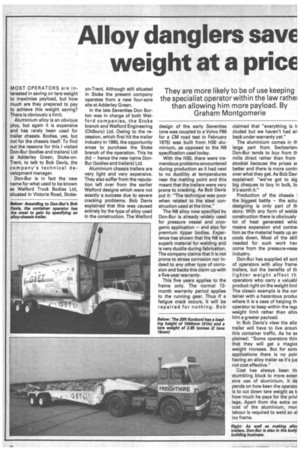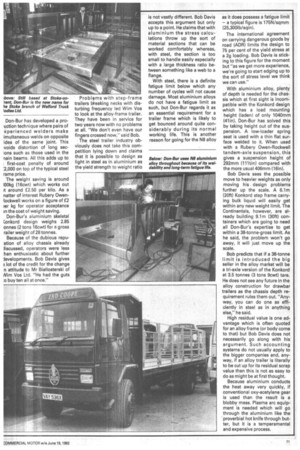Alloy danglers save weight at a price
Page 64

Page 65

If you've noticed an error in this article please click here to report it so we can fix it.
They are more likely to be of use keeping the specialist operator within the law rathei than allowing him more payload. By Graham Montgomerie
MOST OPERATORS are interested in saving on tare weight to maximise payload, but how much are they prepared to pay to achieve this weight saving? There is obviously a limit.
Aluminium alloy is an obvious ploy, but again it is expensive and has rarely been used for trailer chassis. Bodies, yes, but not for the chassis itself. To find out the reasons for this I visited Don-Bur (bodies and trailers) Ltd at Adderley Green, Stoke-onTrent, to talk to Bob Davis, the company's technical development manager.
Don-Bur is in fact the new name for what used to be known as Welford Truck Bodies Ltd, situated in Victoria Road, Stoke on-Trent. Although still situated in Stoke the present company operates from a new four-acre site at Adderley Green.
In the late Seventies Don Burton was in charge of both Welford companies, the Stoke branch and Welford Engineering (Oldbury) Ltd. Owing to the recession, which first hit the trailer industry in 1980, the opportunity arose to purchase the Stoke branch of the operation. This he did — hence the new name DonBur (bodies and trailers) Ltd.
Aluminium chassis trailers are very light and very expensive. They also suffer from the reputation left over from the earlier Welford designs which were not exactly a success due to severe cracking problems. Bob Davis explained that this was caused entirely by the type of alloy used in the construction. The Welford design of the early Seventies (one was coupled to a Volvo F86 for a CM road test in February 1975) was built from H30 aluminium, as opposed to the N8 specification used today.
With the H30, there were tremendous problems encountered during production as it had next to no ductility at temperatures near the melting point and this meant that the trailers were very prone to cracking. As Bob Davis put it: "The technique was poor when related to the steel construction used at the time."
The N8 alloy now specified by Don-Bur is already widely used for pressure vessel and cryogenic application — and also for premium tipper bodies. Experience has shown that the N8 is a superb material for welding and is very ductile during fabrication. The company claims that it is not prone to stress corrosion nor indeed to any other type of corrosion and backs this claim up with a five-year warranty.
This five years applies to the frame only. The normal 12month warranty period applies to the running gear. Thus if a fatigue crack occurs, it will be repaired for nothing. Bob
claimed that "everything is ii eluded but we haven't had an back under warranty yet."
The aluminium comes in th large part from Switzerlam Don-Bur tends to buy from th mills direct rather than from stockist because the prices al better and there is more contn over what they get. As Bob Dav explained: "we've got to sig big cheques to buy in bulk, Ix it's worth it."
Production of the chassis the biggest battle — the actui designing is only part of th story. With any form of welde construction there is obviously lot of heat generated whic means expansion and contra tion as the material heats up an cools down. Most of the skill needed for such work hay come from the pressure-vesst industry
Don-Bur has supplied all sort of operators with alloy frame trailers, but the benefits of th lighter weight affect th operators who carry a valuabl product right on the weight limi The classic example is the cor tamer with a hazardous produc where it is a case of helping th operator to keep within the legi weight limit rather than alio% him a greater payload.
In Bob Davis's view the allo trailer will have to live arouni this container traffic. As he e) plained: "Some operators thin that they will get a magicz weight increase. But for sorry applications there is no poin having an alloy trailer as it's jus not cost effective."
Cost has always been thi stumbling block to more exten sive use of aluminium. It de pends on how keen the operate is to cut down tare weight as ti how much he pays for the privi lege. Apart from the extra on cost of the aluminium, mon labour is required to weld an al loy frame. Don-Bur has developed a prouction technique where pairs of xperienced welders make imultaneous welds on opposite ides of the same joint. This Voids distortion of long secions such as those used in the nain beams. All this adds up to I first-cost penalty of around :2,000 on top of the typical steel rame price.
The weight saving is around 100kg (16cwt) which works out it around £2.50 per kilo. As a natter of interest Rubery Oweniockwell works on a figure of £2 )er kg for operator acceptance )n the cost of weight saving.
Don-Burs aluminium skeletal Conkord design weighs 2.85 onnes (2 tons 16cwt) for a gross railer weight of 28 tonnes.
Because of the dubious repuation of alloy chassis already liscussed, operators were less han enthusiastic about further ievelopments. Bob Davis gives lot of the credit for the change n attitude to Mr Biallosterski of Nim Vos Ltd. "He had the guts :o buy ten all at once." Problems with step-frame trailers breaking necks with disturbing frequency led Wim Vos to look at the alloy-frame trailer. They have been in service for two years now with no problems at all. "We don't even have our fingers crossed now," said Bob.
The steel trailer industry obviously does not take this competition lying down and claims that it is possible to design as light in steel as in aluminium as the yield strength to weight ratio is not vastly different. Bob Davis accepts this argument but only up to a point. He claims that with aluminium the stress calculations throw up the sort of material sections that can be worked comfortably whereas, with steel, the section is too small to handle easily especially with a large thickness ratio between something like a web to a flange.
With steel, there is a definite fatigue limit below which any number of cycles will not cause damage. Most aluminium alloys do not have a fatigue limit as such, but Don-Bur regards it as an essential requirement for a trailer frame which is likely to get bounced around quite considerably during its normal working life. This is another reason for going for the N8 alloy as it does possess a fatigue limit — a typical figure is 175N/sqmm (25,300Ib/sqin).
The international agreement on carrying dangerous goods by road (ADR) limits the design to 75 per cent of the yield stress at a 2g loading. Bob Davis is sticking to this figure for the moment but "as we get more experience, we're going to start edging up to the sort of stress level we think we can use."
With aluminium alloy, plenty of depth is needed for the chassis which at first sight is incompatible with the Konkord design which has a load mounting height (laden) of only 1040mm (41in). Don-Bur has solved this by taking height out of the suspension. A low-loader spring seat is used with a thin flat surface welded to it. When used with a Rubery Owen-Rockwell tandem-axle suspension, this gives a suspension height of 292mm (111/2in) compared with the more usual 406mm (16in).
Bob Davis sees the possible move to heavier weights as only moving his . design problems further up the scale. A 6.1m (20ft) Konkord step frame carrying bulk liquid will easily get within any new weight limit. The Continentals, however, are already building 9.1m (30ft) containers which are going to need all Don-Burs expertise to get within a 38-tonne-gross limit. As he said, the problem won't go away, it will just move up the scale.
Bob predicts that if a 38-tonne limit is introduced the big seller in the alloy market will be a tri-axle version of the Konkord at 3.5 tonnes (3 tons 9cwt) tare. He does not see any future in the alloy construction for drawbar trailers as the chassis depth requirement rules them out. "Anyway, you can do one as efficiently in steel as in anything else," he said.
High residual value is one advantage which is often quoted for an alloy frame (or body come to that) but Bob Davis does not necessarily go along with his argument. Such accounting systems do not usually apply to the bigger companies and, anyway, if an alloy trailer is literally to be cut up for its residual scrap value then this is not as easy to do as might be at first thought.
Because aluminium conducts the heat away very quickly, if conventional oxy-acetylene gear is used than the result is a blobby mess. Plasma arc equipment is needed which will go through the aluminium like the 'proverbial hot knife through butter, but it is a temperamental and expensive process.










































































